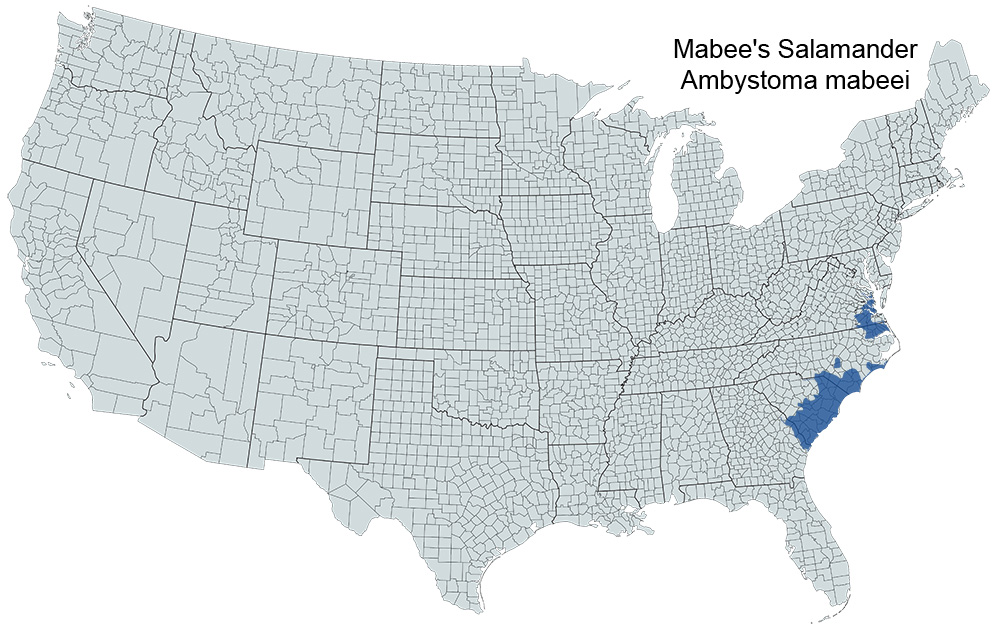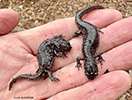Mabee's Salamander
Ambystoma mabeei
Common Name: |
Mabee's Salamander |
Scientific Name: |
Ambystoma mabeei |
Etymology: |
|
Genus: |
Amby is Greek for "a cup", stoma is Greek for "a mouth" |
Species: |
mabeei is in honor of W. B. Mabee, who collected the first specimen known to science. |
Average Length: |
3 - 4 in. (7.5 - 10.2 cm) |
Virginia Record Length: |
|
Record length: |
4.5 in. (11.4 cm) |
Virginia Wildlife Action Plan Rating Tier II (Very High Conservation Need) - Has a high risk of extinction or extirpation. Populations of these species are at very low levels, facing real threat(s), or occur within a very limited distribution. Immediate management is needed for stabilization and recovery.
Physical Description - This species has a relatively small head and long slender toes. Silvery white flecks are abundant on sides, but sparse on the back. The color above is deep brown and the vomerine teeth are not in multiple series and wholly between the inner nares. The teeth on the margins of the jaw are in a in a single row. There are 13 costal grooves, counting two in groin. The length is up to 102 mm. This is a small, stout moe salamander with a relatively small head reaching a maximum SVL of 71.7 mm (2.75 inches) and a maximum total length of 122.1 mm (4.75 inches). The tail comprises approximately 68% of the total length. The snout is rounded and projects beyond the lower jaw. The head is widest at the corner of the mouth. The eyes are small yet prominent. The forelimbs are slender, the hindlimbs more stout, but not muscular. The toes are characteristiclly long, with the longest toes on the hind feet being greater than 50% of the foot length. There are 13 coastal grooves and 1-1.5 coastal folds lie between the adpressed limbs. The tail is compressed in the distal half. The color in life is dark brown to gray-brown above and paler below. Whitish flecks occur laterally and may be so abundant as to form a mottled pattern. Such markings continue ventrolaterally on the body and extend laterally the entire length of the tail. These whitish markings run onto the dorsum, but usually become more sparse, brownish, and indistinct. The underside is brown to brownish-gray, sometimes mottled with grayish markings on the throat. The males are about 15% longer than the females. During the breeding season gravid females are noticeably more rotund than the males and spent females. At this time the males have swollen vents. Hatchling larvae from North Carolina average 8.5 mm total length and begin transformation at about 50 mm. Metamorphs from Southampton County are 60.1-70.4 mm total length. Larvae are of the pond type, brown and cream to yellow above, and pale with semi-translucent skin below. The dorsal fin originates above the forelegs and is , at its highest, as high as the tall musculature. The tail is mottled with brown, except at the base where there is a characteristic light mid-dorsal stripe. The body has 2-3 dark stripes on the sides which usually merge on the tail. The most ventral two lateral stripes are sometimes difficult to discern. Larvae of this species differ from others in having an immaculate venter, a mid-dorsal light stripe including the base of the fin, and rounded toes.
Historical versus Current Distribution - The historical distribution of Mabee's Salamanders (Ambystoma mabeei) is unknown. Mabee's Salamanders occur entirely in the Atlantic Coastal Plain and extend from Gloucester County, Virginia, to the southern tip of South Carolina (Mosimann and Rabb, 1948; Mitchell and Hedges, 1980; Ensley and Cross, 1984; Petranka, 1998; Mitchell and Reay, 1999). There are no records west of the Fall Line
Historical versus Current Abundance - There are no published estimates of population size for Mabee's Salamanders. Maximum number of larval salamanders caught in 1963 with a minnow seine in four ponds in North Carolina was 51, 97, 115, and 212 (Hardy, 1969b). Roble (1998) reported that Mabee's Salamanders were confirmed in 17 of 50 natural sinkhole ponds in the Grafton Plains area in the city of Newport News and York County, Virginia. Up to 100 larvae were caught on single visits to three of these ponds. A total of 183 individuals was caught in 1995–'97, compared to 821 marbled Salamanders (Ambystoma opacum) encountered during that period, suggesting that the best known population of Mabee's Salamanders in Virginia exists in low densities (Roble, 1998). 3. Life History Features. The life history and biology of Mabee's Salamanders have been summarized by Pague and Mitchell (1991a) and Petranka (1998). Mabee's Salamanders possess an aquatic larval stage and terrestrial juvenile and adult stages.
Breeding - Reproduction is aquatic.
Breeding migrations - During rains, adults migrate en masse from terrestrial retreats to breeding ponds during the winter (Hardy, 1969a). Movement distances are unknown. Hardy (1969b) found 91 recently transformed Mabee's Salamanders under boards approximately 800 meters from the nearest water. Roble (1998), however, found no mass migrations in Virginia using drift fences and pitfall traps.
Breeding habitat - Mabee's Salamanders breed in small, shallow, typically ephemeral to semi-permanent wetlands that are usually free of fishes (Petranka, 1998). A wide variety of pools support breeding populations, including farm ponds, water-filled foxholes, vernal pools in pine and hardwoods, Carolina bays, sinkhole ponds, and cypress-tupelo ponds in pinewoods (Hardy, 1969a; Hardy and Anderson, 1970; Roble, 1998).
Egg deposition sites - Mating and egg laying occur in winter, extending from December–March depending on weather conditions. Courtship occurs during winter rains. Eggs vary from 5.1–5.9 mm in diameter and are deposited singly or in loosely connected clusters of 2–6 eggs (Hardy, 1969a). Eggs are attached to vegetation on the pond substrate.
Clutch size - Undescribed. Hatching occurs in 9–14 d at about 9 mm TL. Metamorphosis occurs in April–May depending on when eggs were deposited
Altig & McDiarmid 2015 - Classification and Description:
- Eastern Other - Oviposited as independent arrangements other than arrays or probable arrays that are difficult to recognize because of the small number of eggs or non-uniform substrate; most often in nonflowing water.
- Arrangement 3 - jelly is flimsy.
- Sub-arrangement A - Eggs deposited in temporary wooded pools; Ovum Diameter 2.0-2.5 mm; 3 jelly layers; jelly matrix watery.
- Arrangement 3 - jelly is flimsy.
Larvae/Metamorphosis - The larval stage lasts a few months (Petranka, 1998). Size at metamorphosis in North Carolina was estimated at 55–60 mm total length (Hardy, 1969b). Metamorphic animals with gill buds from Virginia were 60.1–78.6 mm total length (mean = 70.4; Mitchell and Hedges, 1980).
Juvenile Habitat - Juvenile habitat appears to be similar to adult habitat, but this aspect of the ecology of Mabee's Salamanders has not been studied. Hardy (1969b) noted that a large number of recently transformed juveniles were found under coverboards in an overgrown tree-shaded lawn adjacent to an open field.
Adult Habitat - Adults use terrestrial habitats extensively outside of the breeding period. Terrestrial habitat includes open fields, pine forest, and hardwood forest (Hardy, 1969b).
Home Range Size - Unknown. Movements of adults have not been studied but observations by Hardy (1969b) suggest that some individuals remain close to breeding ponds during the remainder of the year.
Territories - Territoriality has not been described in Mabee's Salamanders.
Aestivation/Avoiding Desiccation - Adults and juveniles are fossorial during the non-breeding months. We do not know if individuals are active year-round underground or if they aestivate during dry periods. Adults have been found under logs in the bottom of breeding ponds during a late August to November drought (Hardy, 1969b).
Seasonal Migrations - Recently metamorphosed juveniles migrate from natal ponds and are known to disperse ≤ 0.8 kilometers (Hardy, 1969b).
Torpor (Hibernation) - Because Mabee's Salamanders breed in the winter, they are unlikely to exhibit winter torpor.
Interspecific Associations/Exclusions - In aquatic habitats, Mabee's Salamanders have been found in association with Tiger Salamanders (A. tigrinum), Marbled Salamanders, Mole Salamanders (A. talpoideum), Lesser Sirens (Siren intermedia), Southern Two-lined Salamanders (Eurycea cirrigera), Dwarf Salamanders (Eurycea quadridigitata), and Eastern Newts (Notophthalmus viridescens; Hardy, 1969a; Roble, 1998). As many as ten species of frogs and one fish, eastern mudminnows (Umbra pygaea), have been found in ponds containing Mabee's Salamanders (Roble, 1998).
Age/Size at Reproductive Maturity - Age at maturity is unknown for either sex. The smallest male known from Virginia was 55 mm SVL, the smallest female was 53 mm SVL (unpublished data).
Longevity - Snider and Bowler (1992) reported a longevity record for a captive individual of unknown sex as 8 yr, 9 mo, 23 d. Longevity in nature is unknown.
Feeding Behavior - Larval Mabee's Salamanders feed on zooplankton and other small invertebrates (Petranka, 1998). Hardy (1969b) noted that adults caught on land in March–April had eaten earthworms
Predators - Known predators are Tiger Salamander larvae and Lesser Direns (Hardy, 1969b). Petranka (1998) added odonate naiads and dytiscid beetle larvae.
Anti-Predator Mechanisms - Mabee's Salamanders possess passive antipredator displays that include lashing the tail weakly toward a touch, coiling the body with the head under the base of the tail, tail undulation, and, when touched, assuming an immobile position with the forelimbs clasped along the body (Brodie, 1977). Individual salamanders exhibited these display behaviors for 8.5–87 s (mean = 40.5 s) when approached by a small snake (Dodd, 1977b).
Diseases - No diseases have been reported.
Parasites - Parasites have not been reported.
Conservation - Mabee's Salamanders are listed as a Threatened species in Virginia (Mitchell and Reay, 1999). Threats include habitat fragmentation, aquatic and terrestrial habitat loss, road mortality, and alteration of hydrology mostly due to urbanization. One Mabee's Salamander site, a 151 ha portion of the Grafton area sinkhole pond complex in the city of Newport News, was dedicated in 1995 as a Virginia Department of Conservation and Recreation Natural Area Preserve (Clark, 1998).
References
- Altig, Ronald & McDiarmid, Roy W. 2015. Handbook of Larval Amphibians of the United States and Canada. Cornell University Press, Ithaca, NY. 341 pages.
- AmphibiaWeb. 2020. University of California, Berkeley, CA, USA.
- Mitchell, J.C., Hedges, S.B., 1980, Ambystoma mabeei Bishop (Caudata: Ambystomatidae): An addition to the salamander fauna of Virginia, Brimleyana, Vol. 3, pg. 119-121
- Bishop, S.C., 1943, Handbook of Salamanders, 555 pgs., Comstock Publ. Co., New York, NY
- Martof, B.S., Palmer, W.M., Bailey, J.R., Harrison, III J.R., 1980, Amphibians and Reptiles of the Carolinas and Virginia, 264 pgs., UNC Press, Chapel Hill, NC
- Terwilliger, K.T., 1991, Virginia's endangered species: Proceedings of a symposium. Coordinated by the Virginia Dept. of Game and Inland Fisheries, Nongame and Endangered Species Program, 672 pp. pgs., McDonald and Woodward Publ. Comp., Blacksburg, VA
Photos:
*Click on a thumbnail for a larger version.
Verified County/City Occurrence
Gloucester
Isle of Wight
James City
Mathews
Southampton
Surry
Sussex
York
CITIES
Hampton
Newport News
Suffolk
Verified in 8 counties and 3 cities.
U.S. Range











